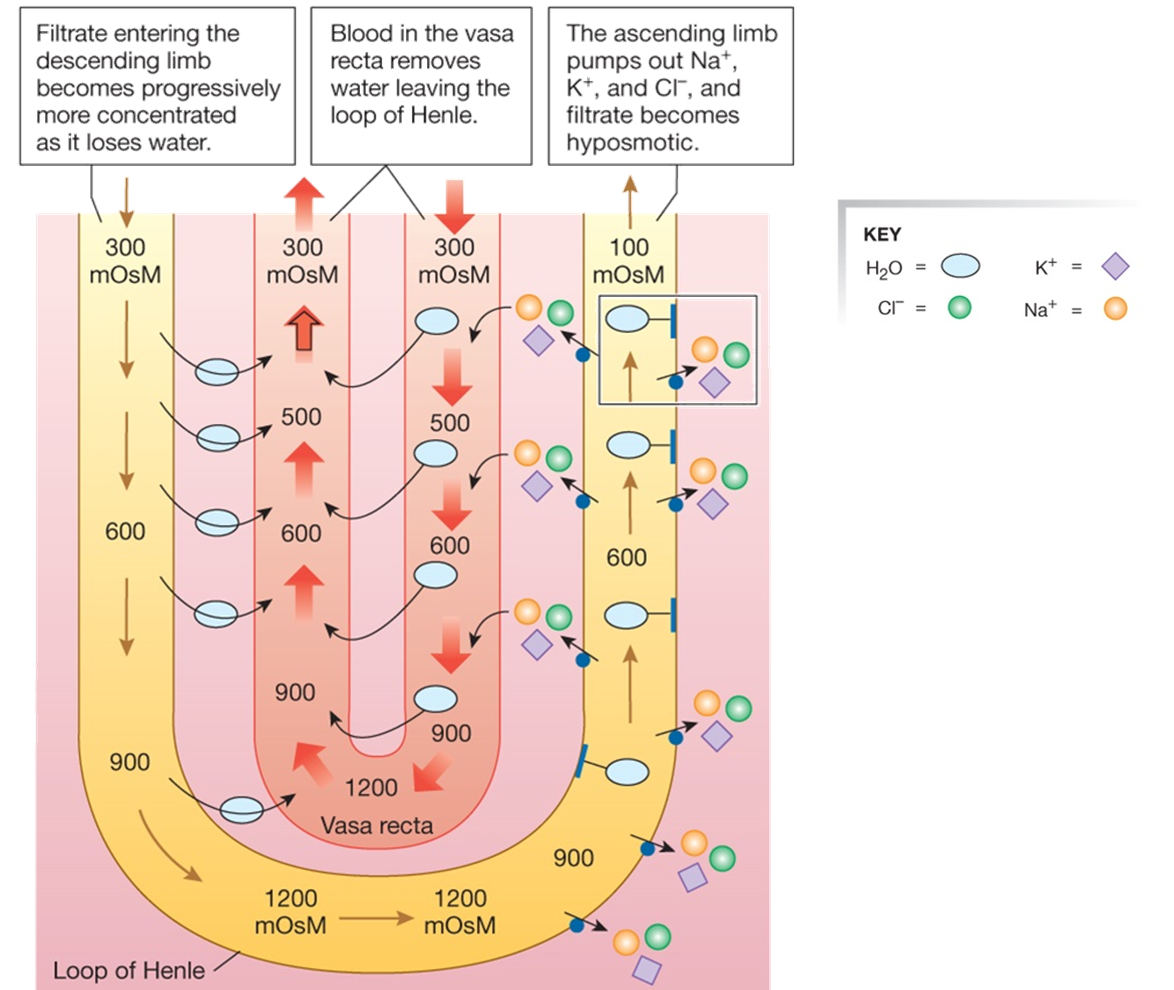In-Depth Notes on Blood Osmolarity Regulation and Renal Function
1/19
There's no tags or description
Looks like no tags are added yet.
Name | Mastery | Learn | Test | Matching | Spaced |
|---|
No study sessions yet.
20 Terms
Blood Osmolarity
The concentration of solutes in the blood, regulated by the kidneys.
Osmolarity increase towards the medulla
Loop of Henle
A U-shaped section of the nephron where water and solutes are reabsorbed, creating a concentration gradient.
Countercurrent Exchange
A mechanism in the vasa recta that maximizes water and solute reabsorption by maintaining a gradient.
This process involves parallel blood flow in opposite directions, allowing for efficient exchange of substances.
Maintain the osmotic gradient in renal medulla
Countercurrent Flow
Blood flow in vasa recta runs counter to the flow of filtrate in the loop of Henle
Blood flows downward while filtrates move upward allowing for efficient exchange
Maintaining Osmotic Gradient
As blood descends into the medulla, it progressively gains water and loses solutes (NaCl) from surrounding interstitial fluid (higher osmolarity due to loop of Henle)
As blood ascends back into the cortex, it gains water and loses solutes completing exchange
Vasa Recta
Capillaries in the renal medulla that surround the Loop of Henle, participating in blood supply and countercurrent exchange.
Long straight capillaries
Importance of Countercurrent Exchange
Allows the kidneys to conserve water while concentrating urine as the medullary interstitial fluid remains hyperosmotic
By preserving high osmolarity of the medulla, the kidneys can produce urine that is much more concentrated than the blood plasma, this is crucial form maintaining the body’s fluid and electrolyte balance
Antidiuretic Hormone (ADH)
Hormone that regulates water reabsorption in the collecting duct, increasing permeability to water.
Aldosterone
A steroid hormone that promotes sodium reabsorption and potassium secretion, part of the RAAS system and acts as a transcription factor
Aldosterone combines with a cytoplasmic receptor, the hormone complex initiates transcription in the nucleus, translation and protein synthesis makes new channels and pumps, aldosterone induced protein modulate existing channels and pumps and results in increased Na reabsorption and K secretion
Micturition
The process of urine excretion, controlled by a spinal reflex influenced by the brain.
At rest the bladder is relaxed and the CNS tonically inhibits by telling the skeletal muscle sphincter to stay contracted
When bladder fills, stretch receptors fire send information via a sensory receptor this causes the PNS neurons fire which stops the motor neuron from firing and stops contraction of the external sphincter, allowing urine to flow out.
Renin-Angiotensin-Aldosterone System (RAAS)
Part of a complex feedback circuit that functions in homeostasis
A hormone system regulating blood pressure and fluid balance, triggered by low blood pressure.
A drop in bp near the glomerulus triggers the release of aldosterone in adrenal gland
Leads to reabsorption of sodium and increased K secretion
This requires the synthesis of new sodium pumps
Hyposmotic Fluid
Fluid with a lower osmolarity compared to plasma, produced in the thick ascending limb of the loop of Henle.
Isosmotic Fluid
Fluid that has the same osmolarity as plasma, exiting the proximal tubule.
Filtrate
Fluid that passes through the nephron, undergoing processes of reabsorption and secretion to form urine.
How does the loop of Henle ensure higher osmolarity in the medulla?
The loop of Henle utilizes a countercurrent multipliers system where the descending limb is permeable to water but not to solutes, allowing water to be reabsorbed into the hyperosmotic medullary interstitium. The ascending limb, conversely, is impermeable to water and actively transports salts out, which increases the osmolarity of the surrounding interstitial fluid. This process helps maintain a high osmolarity in the medulla.
Draw and Explain Countercurrent Exchange

What is the role of urea in countercurrent exchange?
Urea contributes to the osmotic gradient in the renal medulla through a process known as the urea recycling mechanism. As urea is reabsorbed from the collecting ducts, it enters the interstitial fluid, increasing its osmolarity. This higher concentration of urea helps to maintain a hyperosmotic environment that promotes water reabsorption from the loop of Henle and the collecting ducts, enhancing the kidney's ability to concentrate urine.
What is the role of vasopressin in the kidneys?
Vasopressin, also known as antidiuretic hormone (ADH), regulates water reabsorption in the kidneys. It increases the permeability of the collecting ducts to water by promoting the insertion of aquaporin channels, allowing more water to be reabsorbed into the bloodstream. This action enhances the concentration of urine and helps to maintain the body's fluid balance
Allows water to move from the urine to the interstitial fluid then blood, reducing urine volume.
Water leaves by osmosis by vasa recta and urine is concentrated
Absence of vasopressin makes collecting ducts impermeable to water, resulting in dilute urine production and increased urine volume and urine is more dilute
Homeostasis of Blood Osmolarity
Decreased blood pressure, decreased arterial stretch due to low blood volume, and an osmolarity greater than 280 are factors that trigger the synthesis of vasopressin
From the hypothalamus, vasopressin is synthesized and transported by vesicles down the neurons and is stored in the posterior pituitary where it is then released into the blood
Diuretic
Alcohol inhibits the release of ADH which is an antidiuretic hormone responsible for water reabsorption in the kidneys, leading to increased urine output.
Bedwetting can be prevented by depressing this system